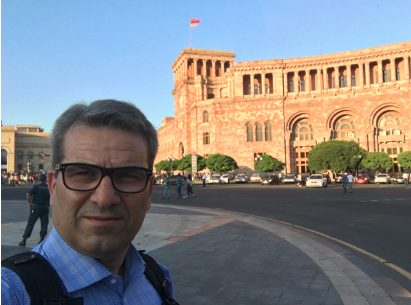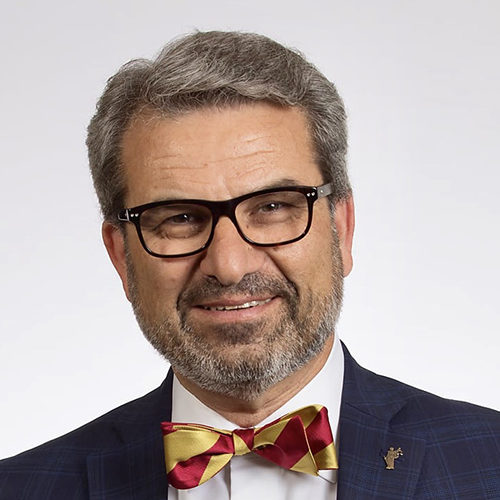There is no reason why lasting peace cannot be accomplished in the Caucasus. However, the negotiation’s current competitive nature among an incomplete set of stakeholders cannot possibly yield the desired outcome. No solution is possible through violence. No solution is feasible without the Republic of Nagorno Karabakh (Artsakh) seated at the negotiating table. No solution is implementable without a sustained ceasefire, including an international peace keeping force, if necessary, to enforce it. Unfortunately, Azeri aggression is based on ethnic ambitions fueled by its ally Turkey looking “to finish” what they started, according to President Erdogan. This chilling admission is all too real for a generation of Armenians, who are direct descendants of survivors of the first Genocide of the 20th Century perpetrated by the Ottoman Turks.
Armenians inhabited the Trans-Caucasus, including Artsakh, for over several millennia. During the Sovietization of this region, in an attempt to appease Turkey after WWI, Joseph Stalin established the Nagorno-Karabakh Autonomous Region – where 80% of the population was ethnically Armenian living on their ancestral lands-within Azerbaijan SSR. Under the Bolshevik rule, the ethnic conflicts were kept under control.

However, upon the Soviet Union’s apparent collapse, ethnic tensions rose, forcing the first referendum of Artsakh in 1988, when the people of Artsakh decided with an overwhelming majority (80% approximately) to join Armenia. When the Union of Soviet Socialist Republics (USSR) and Azerbaijan SSR refused to honor the annexation referendum, Armenians took to the streets of Yerevan (Armenia) and Stepanakert (Artsakh) to protest and demand policies of “perestroika” and “glasnost,” both newly minted concepts in Soviet system. These protests are well documented in the American media as many articles in the New York Times, The Atlanta Constitution, the Chicago Tribune and the Miami Herald, among others, covered stories like “Armenians mount major protests over Soviet policy.” (New York Times, February 24, 1988).

In existing law, Artsakh’s referendum used Article 2 and 3 of Soviet Secession laws allowing every republic and autonomous regions to leave the Union. In retaliation, Azerbaijan SSR organized extreme violence against ethnic Armenians leading to the pogroms of Sumgait, Azerbaijan in February of 1988 and of Baku in January of 1990. By all accounts, the carnage resulted in the effective expulsion of Armenians’ surviving population from Baku to Armenia and Artsakh.
As the USSR dissolved, Artsakh, through a second referendum, officially declared its independence in 1991. War erupted between the Armenian side and Azerbaijan, killing more than 30,000 people. The Armenian side was victorious in controlling Artsakh and the surrounding territory as a buffer zone. During the vicious conflict, the UN Security Council passed four resolutions in 1993, condemning violence and seeking the warring parties’ return to the negotiating table.
The Azerbaijani government, to this day, cites these resolutions to claim territorial sovereignty. The primary purpose of the UN Security Council is not to adjudicate territorial integrity instead to promote peace and security. The UN was well aware of the conflict and its nature but attempted to get both sides to the negotiating table. Reading these resolutions without regard to the events leading to the referenda in Artsakh and the votes for self-determination undermines the primary UN principles found in Chapter I and in Article 2 of the UN. That article states, “to develop friendly relations among nations based on respect for the principle of equal rights and self-determination of peoples, and to take other appropriate measures to strengthen universal peace.”
This UN principle was what Artsakh sought 29 years ago and still seeks today. To negotiate lasting peace, as was negotiated in Kosovo, Artsakh and Azerbaijan must promote a path to the “pacific settlement” of this dispute in line with the Security Council’s mandate under Chapter VI of the UN Charter. They must head to the advice of the Preamble of the UN Charter. The Preamble affirms, “We the peoples of the United Nations determined to save succeeding generations from the scourge of war…reaffirm faith in fundamental human rights, in the dignity and worth of human person…of nations large and small…and for these ends practice tolerance and live together in peace with one another as good neighbors.” Until Azerbaijan commits to these ideals to reframe the conflict, there will be no lasting peace in the Caucasus.
*Frank V. Zerunyan, J.D. is a Professor of the Practice of Governance and Director of Executive Education and ROTC Programs at the University of Southern California Sol Price School of Public Policy and is the co-author of the book “Newgotiation for Public Administration Professionals”

Frank V. Zerunyan is a Professor of the Practice of Governance at the University of Southern California (USC) Sol Price School of Public Policy (USC Price) and Director of Executive Education. He is the founding director of the USC Price Center on National Defense and Public Safety. Professor Zerunyan oversees USC’s Reserve Officers’ Training Corps (ROTC) as the Director and University Liaison for the U.S. Air Force, Army, Naval Reserves ROTC, and Nautical Science Programs.
Professor Zerunyan’s principal areas of expertise include governance, public-private partnerships, civic and ethical leadership, land use, medical regulation, negotiation, and executive education. He lectures locally and globally to build capacity and foster leadership among public executives worldwide. He is the author of books, book chapters, and many short articles published nationally, internationally, and on USC Price’s “Faculty Perspectives.” Professor Zerunyan is often quoted in the media and is a USC resource for journalists as an expert in governance and leadership. He is also an expert on public administration at the United Nations Innovation Branch (formerly Capacity Building Branch).
For his influential advisory role in the Republic of Armenia, he was awarded LL.D. Doctor of Laws – Honoris Causa by the Public Administration Academy of the Republic of Armenia. Professor Zerunyan designs curricula and teaches at the American University in Armenia, Yerevan State University, and the Vazgen Sargsyan Military University in Armenia, with an honorary rank of colonel. He also teaches for the U.S. Navy at the U.S. Naval Service Training Command.
Professor Zerunyan serves on the editorial boards of the Public Administration Scientific Journal for the Republic of Armenia and the Ukrainian Law Review. He is on the board of councilors of Anahuac University Law School, Xalapa, Mexico (Consejo Consultivo de la Escuela de Derecho).
Professor Zerunyan earned his Doctor of Jurisprudence (Doctor of Laws) degree from Western State University College of Law and his Bachelor of Arts degree from California State University, Long Beach. He also completed his advanced legal education in Corporate Taxation at the University of Southern California Law Center (USC Gould). He is a graduate of the California League of Cities’ Civic Leadership Institute.
Professor Zerunyan, trained and practiced as a lawyer, is a four-term Mayor and Councilmember in the City of Rolling Hills Estates, California. He serves on several city, county, and regional policy boards and committees. He was also a gubernatorial appointee under Governor Schwarzenegger, serving 38 million medical consumers on the Medical Board of California.
